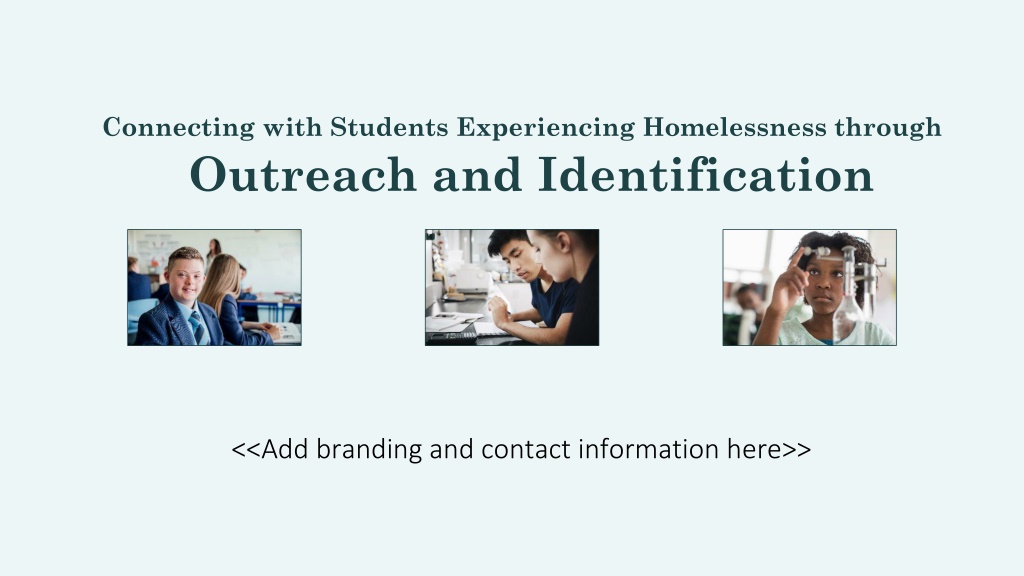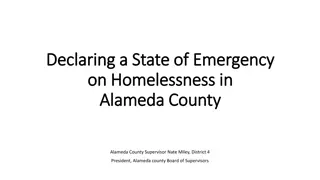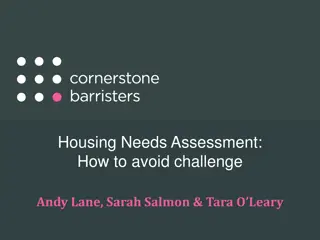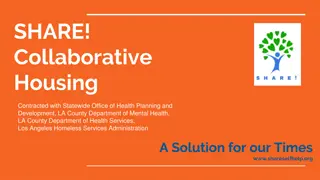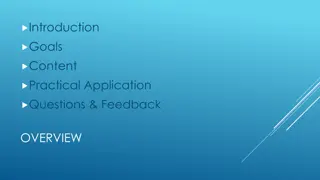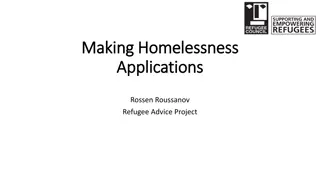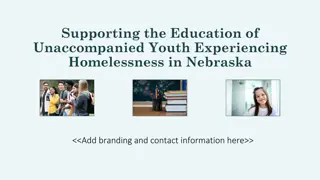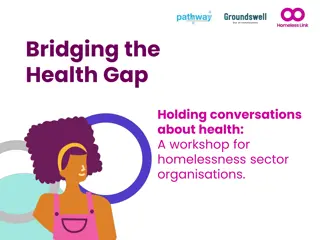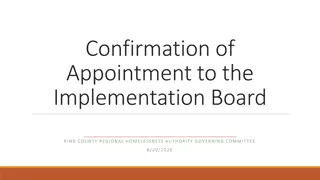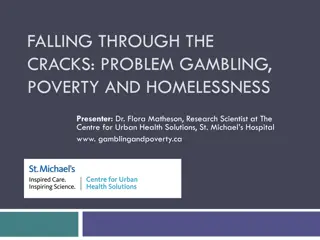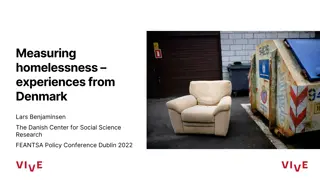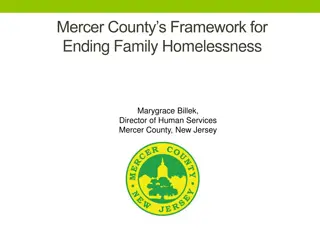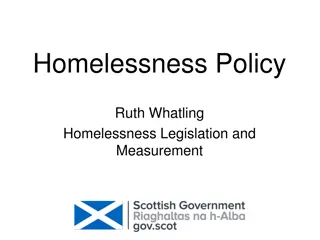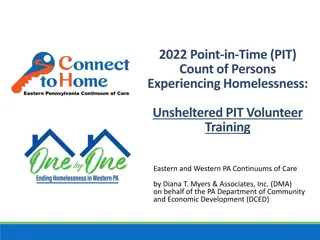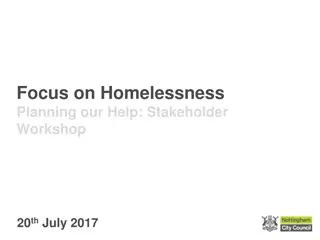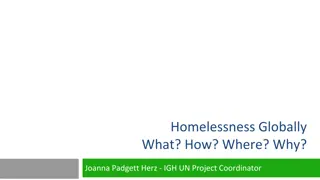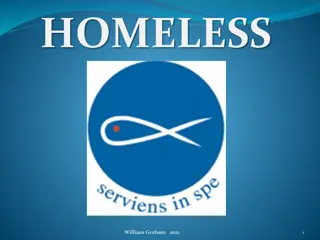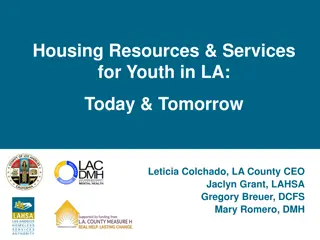Empowering Students Experiencing Homelessness: Strategies and Resources
Empower students experiencing homelessness by understanding McKinney-Vento Act provisions, implementing effective outreach and identification strategies, and supporting them in overcoming educational barriers. Learn how to connect with designated liaisons, define homelessness, and access valuable resources for further information and assistance. Explore the nuances of rural versus urban youth homelessness rates and become informed advocates in addressing this critical issue.
Download Presentation

Please find below an Image/Link to download the presentation.
The content on the website is provided AS IS for your information and personal use only. It may not be sold, licensed, or shared on other websites without obtaining consent from the author. Download presentation by click this link. If you encounter any issues during the download, it is possible that the publisher has removed the file from their server.
E N D
Presentation Transcript
Connecting with Students Experiencing Homelessness through Outreach and Identification <<Add branding and contact information here>>
Todays Roadmap Outreach and identification McKinney-Vento Act provisions Strategies for implementation Resources for more information
Warm-Up Question True or False? True or False? According to research by the University of Chicago, the rate of homelessness in urban areas is four times (4x) the rate of homelessness in rural areas.
McKinney-Vento Basics Subtitle VII-B of the McKinney-Vento Homeless Assistance Act Was reauthorized by Title IX, Part A of the Every Student Succeeds Act Establishes the definition of homeless used by U.S. public schools Addresses the unique educational barriers and challenges faced by students experiencing homelessness Requires state education departments to designate a State Coordinator for Homeless Education and school districts to designate a local homeless education liaison; access contact information at https://www.education.ne.gov/federalprograms/title-vii-b/
McKinney-Vento Definition of Homeless Children and youth who lack a fixed, regular, and adequate nighttime residence, lack a fixed, regular, and adequate nighttime residence, including Sharing the housing of other persons, due to loss of housing, economic hardship, or a similar reason Living in cars, parks, public spaces, abandoned buildings, substandard housing, bus or train stations, or similar settings Living in motels, hotels, trailer parks, camping grounds due to the lack of alternative adequate accommodations Migratory children living in the above circumstances 42 U.S.C. 11434a(2) Living in emergency or transitional shelters, or abandoned in hospitals Unaccompanied youth (children and youth experiencing homelessness while not in the physical custody of a parent or guardian) Living in a public or private place not designed for or ordinarily used as a regular sleeping accommodation 42 U.S.C. 11434a(6)
The Research: Rural v. Nonrural Rates of youth homelessness are statistically identical in rural and nonrural areas Source: Chapin Hall, Missed Opportunities: Youth Homelessness in America, National Estimates
Identification under McKinney-Vento Identification is the first step Identification is the first step to ensuring educational access and success for students experiencing homelessness References to identification are woven throughout the McKinney- Vento Act, including as A state and district responsibility [42 U.S.C. 11431(2); 42 U.S.C. 11432(d)(2); 42 U.S.C. 11432(g)(1)(B); 42 U.S.C. 11432(g)(7)] A duty of the local liaison [42 U.S.C. 11432(g)(6)(A)(i)]
Identification under McKinney-Vento A data collection and public posting requirement [42 U.S.C. 11432(f)(1)(A)] A focus of professional development for local liaisons and district/school staff [42 U.S.C. 11432(d)(5)(A)] A focus of school-community coordination [42 U.S.C. 11432(g)(5)(C)(i)] A focus of district subgrant funds usage [42 U.S.C. 11433(a)(1); 42 U.S.C. 11433(c)(2)(A)]
Outreach under McKinney-Vento Liaisons must ensure that children and youth experiencing homelessness are identified by school personnel school personnel through outreach and coordination activities with other entities and agencies [42 U.S.C. 11432(g)(6)(A)(i)] identified by Student Rights Liaisons must ensure that public notice homeless students rights is posted in an understandable manner in locations frequented by parents, guardians, and unaccompanied youth [42 U.S.C. 11432(g)(6)(A)(vi)] public notice of
Outreach under McKinney-Vento State Coordinators and school districts must inform school personnel, community partners, and children, youth, and parents/guardians experiencing homelessness of the duties of the local liaison the local liaison [42 U.S.C. 11432(g)(6)(B)] Liaison Duties duties of State Coordinators must publish an annually updated liaison list updated liaison list on the state education department s website [42 U.S.C. 11432(g)(6)(B)] annually
Identification Benchmarks Experiences of homelessness are correlated with experiences of poverty Consider the following benchmarks when assessing district identification efforts 5 5- -10% 10% of students eligible to receive free or reduced- price meals 10% of students experiencing poverty Source: Auditor of the State of California, Youth Experiencing Homelessness: California s Education System for K 12 Inadequately Identifies and Supports These Youth Sources: Urban Institute, What Will It Take to End Homelessness? Census Bureau: Poverty Estimates by School District by School Year
Outreach and Identification Strategies Create a centralized phone number centralized phone number and/or website and/or website for accessing information and supports Leverage community partners community partners to share information and refer children, youth, and families Reach out to previously identified previously identified students students using information on file Leverage existing distribution channels distribution channels to share information (school meals and other supports) Create and distribute simple awareness materials materials (flyers, posters) where youth and families may congregate awareness Leverage technology email, etc.) technology (social media, text,
Outreach and Identification Strategies Include housing questions in enrollment forms forms (online and paper); ensure immediate enrollment without proof of residence Consider engaging outreach teams including school counselors, school social workers, school-based partner organization staff, and other appropriate staff enrollment outreach teams , Consider supporting increased liaison capacity capacity and/or designating school-level points of contact to extend the liaison s reach increased liaison Incorporate information into district and school staff training and school staff training about recognizing homelessness and referring students in need to help district
Outreach and Identification Strategies Use sensitive and intentional language sensitive and intentional language in outreach materials Be consistent and persistent consistent and persistent; multiple outreach attempts may be needed Describe living situations rather than use the word homeless Keep communications and awareness materials clear and simple clear and simple Create a safe space for accessing help Share information in common languages languages in your community common Relieve concerns about child welfare involvement Check in regularly Check in regularly once a connection has been made
Cool-Down Question Consider Consider Which outreach or identification strategy shared today might you use moving forward? What next step do you need to take to implement this strategy?
Resources NCHE educational rights posters Youth version, English Youth version, Spanish Parent version, English Parent version, Spanish Order in hard copy (free in limited quantity) at https://nchehelpline.org/
Resources SchoolHouse Connection Know Your Rights posters New Mexico Public Education Department Homeless Student Referral Form for Community Partners Kern County Schools (CA) community partner student referral form in PDF format | in online format Northwest New Mexico McKinney-Vento Facebook webpage
Thanks for Joining! <<Add branding and contact information here>>
